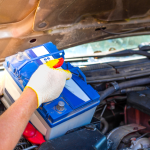As the chill of winter settles in and the landscape transforms into a frosty wonderland, it’s essential to ensure that your vehicle is ready to brave the cold. Winter can present unique challenges for drivers, from icy roads to frigid temperatures, which can take a toll on your car’s performance and safety. That’s why practicing proper winter car care is crucial for maintaining your vehicle’s health and keeping you safe on the road.
In this article, we’ll share essential tips and tricks to help you prepare your car for the winter car months ahead, ensuring you stay warm and worry-free while driving. Whether you’re an experienced driver or a newcomer to winter weather, these friendly and informative tips are designed to help you navigate the season with confidence. Let’s get started on making sure your car is winter-ready!
Table of Contents
- Essential Fluids and Their Importance in Winter Driving
- Keeping Your Battery in Top Shape During Cold Months
- Maximizing Tire Performance for Winter Conditions
- Preparing Your Vehicle for Unexpected Winter Weather
- Q&A
- Closing Remarks

Essential Fluids and Their Importance in Winter Driving
As winter approaches, it’s essential to pay special attention to the fluids in your vehicle, as they play a crucial role in maintaining optimal performance during cold weather. Antifreeze is a vital component, preventing your engine from freezing and ensuring it operates smoothly. It’s recommended to check the coolant level regularly and top it up if necessary. Additionally, using a winter-grade windshield washer fluid is essential for maintaining visibility; this fluid is formulated to withstand lower temperatures and prevent freezing on your windshield.
Another critical fluid to monitor is motor oil, which can thicken in colder temperatures. Opting for a lighter viscosity oil, particularly one recommended for winter car care tips conditions, can help your engine start more easily and run efficiently. Don’t forget about brake fluid as well; maintaining the right level is crucial for your braking system, particularly on icy roads. Here’s a quick overview of the essential fluids to check:
| Fluid | Importance | Tip |
|---|---|---|
| Antifreeze | Prevents engine freeze | Check and top up regularly |
| Windshield Washer Fluid | Ensures visibility | Use winter-grade fluid |
| Motor Oil | Ensures smooth engine operation | Use lighter viscosity oil |
| Brake Fluid | Critical for braking system | Keep levels topped off |

Keeping Your Battery in Top Shape During Cold Months
Cold temperatures can put a significant strain on your vehicle’s battery, making it essential to take proactive steps to ensure it remains in optimal condition during the winter months. Here are a few tips to help you keep your battery healthy:
- Check battery health: Regularly inspect your battery for signs of corrosion or damage. A clean connection will ensure better performance.
- Limit short trips: Short trips can prevent your battery from fully charging. Try to combine errands into a single trip to give your battery a chance to recharge.
- Park smart: Whenever possible, keep your car in a garage or sheltered area to protect it from extreme cold. If you must park outside, consider using a battery blanket to maintain warmth.
In addition to these practical tips, it’s wise to keep an eye on your battery’s age. Batteries typically last around three to five years. If yours is approaching this age, consider testing its capacity or replacing it before the cold sets in. Keep an emergency kit in your car that includes jumper cables and a portable jumper starter, just in case you need a boost on particularly frigid mornings. This preparation can save you time and hassle, ensuring you stay on the road despite the winter chill.
- Emergency kit essentials: Jumper cables, portable jumper starter, blankets, and non-perishable snacks.
- Battery replacement signs: Dim headlights, slow engine crank, or warning lights on the dashboard.
Read More: What to Know Before Driving in Snow, Ice and Other Slick Conditions

Maximizing Tire Performance for Winter Conditions
To ensure your vehicle performs optimally in winter conditions, it’s essential to choose the right tires. When selecting winter tires, prioritize those with features designed for cold weather, such as enhanced tread patterns and softer rubber compounds. This will provide better traction on snow and ice, reducing the risk of slippage. When shopping for tires, consider the following:
- Tread Depth: Look for tires with at least 6/32″ of tread depth for effective grip.
- Studded vs. Studless: Decide between studded tires for icy conditions or studless tires that excel in snow and slush.
- Tire Pressure: Regularly check tire pressure, as cold temperatures can cause it to drop, affecting handling and safety.
In addition to selecting the right tires, maintaining them is crucial. Regular rotation and alignment can help prevent uneven wear, extending the life of your winter tires. Additionally, be mindful of any visible signs of wear and tear, such as cracks or bulges, which could compromise performance on slick roads. Here’s a quick reference table for keeping your winter tires in shape:
| Maintenance Task | Frequency |
|---|---|
| Tire Rotation | Every 5,000-7,500 miles |
| Tire Pressure Check | Monthly |
| Visual Inspection | Bi-Weekly |

Preparing Your Vehicle for Unexpected Winter Weather
When winter strikes, ensuring your vehicle is ready for unexpected weather is essential. Start by checking your tires, as they provide the crucial grip needed on slick roads. Look for tires with adequate tread depth and consider switching to winter tires for better traction. Additionally, ensure your wiper blades are in good condition and replace them if they leave streaks on your windshield. Don’t forget to fill your windshield washer fluid with a winter-grade solution to keep your visibility clear. The last thing you want is to be caught in a snowstorm with a clogged washer system.
Another important aspect is your vehicle’s battery, which can lose its charge in cold temperatures. Have it tested to ensure it’s in good shape, and consider replacing it if it’s more than three years old. Check your coolant level and make sure your antifreeze is mixed properly to prevent freezing. It’s also wise to keep an emergency kit in your car. This kit should include essentials like a blanket, flashlight, snacks, a first-aid kit, and basic tools. Here’s a simple overview of what to include:
| Emergency Kit Item | Purpose |
|---|---|
| Blanket | Stay warm in case of a breakdown |
| Flashlight | Find your way in the dark |
| Snacks | Keep your energy up |
| First-aid kit | Address minor injuries |
| Basic tools | Handle minor repairs |
Q&A
Q&A: Winter Car Care Tips
Q1: Why is winter car care important?
A: Winter weather can be tough on vehicles. Snow, ice, salt, and cold temperatures can lead to various issues, from battery failure to tire problems. Proper winter car care helps ensure your vehicle runs smoothly, maintains safety, and prolongs its lifespan.
Q2: What are the key components of winter car maintenance?
A: There are several key aspects to consider, including:
- Battery Check: Cold weather can reduce battery capacity, so have your battery tested and cleaned.
- Tire Care: Ensure your tires have adequate tread depth and consider switching to winter tires for better traction.
- Fluid Levels: Check antifreeze, windshield wiper fluid (use winter-grade), and oil levels.
- Brake System: Ensure your brakes are in good condition to handle winter roads.
- Lights: With shorter days, make sure all lights are functioning properly for visibility.
Q3: How do I prepare my tires for winter?
A: Start by checking the tread depth; it should be at least 4/32 of an inch for safe winter driving. Consider investing in winter tires, which provide better traction on snow and ice. Regularly check tire pressure, as it can drop with colder temperatures; keep them inflated to the manufacturer’s recommended levels.
Q4: Should I keep an emergency kit in my car during winter?
A: Absolutely! An emergency kit is vital during winter. Include blankets, a flashlight, non-perishable snacks, first aid supplies, a shovel, ice scraper, jumper cables, and sand or kitty litter for traction. This way, you’ll be prepared for unexpected situations.
Q5: Can cold weather affect my car’s performance?
A: Yes, cold weather can impact various systems in your car. Engines may take longer to warm up, gas mileage can decrease, and fluids can thicken. Regular maintenance, such as oil changes and fluid checks, can mitigate these effects and keep your car running efficiently.
Q6: How often should I have my car checked in the winter?
A: It’s a good idea to have your vehicle inspected at least once during the winter months. However, frequent checks of key components (like battery, tires, and fluids) can help catch issues early. Pay attention to any changes in performance or unusual sounds, and address them promptly.
Q7: What tips can I follow for driving in winter conditions?
A: Here are some helpful tips for driving safely in winter:
- Drive slowly and increase your following distance.
- Use gentle movements when steering and braking to avoid skidding.
- Keep your gas tank at least half full to prevent your fuel lines from freezing.
- Familiarize yourself with how your vehicle handles on snow and ice before you encounter tough conditions.
Q8: What should I do if I get stuck in snow?
A: If you find yourself stuck, stay calm. Turn your steering wheel back and forth while gently accelerating in a low gear. If that doesn’t work, try placing floor mats or cardboard under your tires for extra traction. If you’re unable to free yourself, call for assistance and stay in your vehicle with the engine running periodically for warmth.
Q9: Are there any special products I should use for winter car care?
A: Yes! Consider using winter-specific products such as:
- De-icing windshield wiper fluid: to prevent freezing
- Antifreeze: check that it’s at the proper level
- Winter-grade engine oil: to ensure optimal performance in lower temperatures
- Tire chains: for extra traction, particularly in heavy snow conditions
Q10: Where can I find more information on winter car care?
A: Begin by checking your owner’s manual for specific manufacturer recommendations. Additionally, local automotive shops, reputable online forums, and automotive websites can offer valuable tips and resources. Always feel free to consult with a trusted mechanic for personalized advice tailored to your vehicle’s needs.
Remember, taking a few proactive steps can keep you safe and your car in great shape during the winter months!
Closing Remarks
As we embrace the colder months, ensuring your vehicle is winter-ready is essential for both safety and performance. By following these winter car care tips, you can navigate through snowy roads and icy conditions with confidence. Regular maintenance, from checking your battery to ensuring your tires are equipped for the season, can make a significant difference in your driving experience. Remember, a little preparation goes a long way in preventing unexpected issues and keeping you and your loved ones safe on the road. So, bundle up, stay vigilant, and enjoy the beauty of winter driving with peace of mind! Safe travels!











